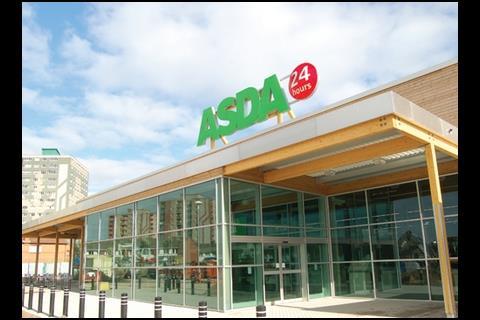Charging for carrier bags is by no means the only contribution retailers are making to waste reduction. As major clients to the construction industry, they are helping drive improvements in waste management too
As the rising commercial cost and taxation of waste adds to the environmental incentive, the business case for action on cutting waste has never been more appealing. Large retail clients such as John Lewis and Asda have already switched on to the waste agenda with schemes to cut single-use carrier bags. But these firms are now looking at ways to reduce waste during their construction projects.
Jennifer Decker, WRAP key account manager for construction, is spreading the word about the government target to halve construction waste to landfill by 2012. ŌĆ£The construction team goes out and advocates the message to top construction clients, and we influence clients to set requirements in their policy for halving waste to landfill. Retail clients have been very engaged. They want to be leaders in their field and theyŌĆÖre keen on looking at sustainable construction.ŌĆØ
WRAP is working closely with construction clients to meet the landfill target. It has compiled an evidence base to identify good practice in waste minimisation and recovery so that organisations can set requirements in their waste strategies. WRAP encourages firms to implement waste management strategies down their supply chains, with the emphasis on resource efficiency.
This calls for a change in approach to waste, particularly by seasoned construction professionals and clients who, in their drive to expand, may have become nonchalant about skipfuls of waste leaving site. If each skip is seen in monetary terms, it makes cutting down waste more critical for all those involved.
ŌĆ£ItŌĆÖs no good saying the physical amount of waste in the skip is the important thing,ŌĆØ says Bob Simpson, head of sustainable development at Asda. ŌĆ£What people need to understand is that waste is cash. Everything that goes in the skip is lost value to us. We try to make the people we work with aware that excessive waste will affect our ability to expand, and have an impact on the business we can give them. All waste affects our bottom line, which will limit the amount of money we can invest.ŌĆØ
The message that waste equals lost cash resonates especially strongly in the present economic conditions and a sharp rise in landfill tax in April this year. ŌĆ£The silver lining to the tougher financial climate is that people are more interested in cutting down on waste because of the cost benefits,ŌĆØ says WRAPŌĆÖs Decker. ŌĆ£If you can reduce the amount of waste you produce, you can significantly reduce the amount of landfill tax you pay. It benefits your corporate social responsibility credentials too, which will then improve your standing with stakeholders, customers and staff.ŌĆØ
AsdaŌĆÖs Simpson echoes the sentiment that cutting down on waste has several benefits. ŌĆ£ItŌĆÖs about being wise for your business as well as for the environment,ŌĆØ he says. ŌĆ£WeŌĆÖve realised with sustainable development that itŌĆÖs great for the bottom line. We want more efficient buildings delivered at a better cost, which weŌĆÖll get from eliminating waste of energy, materials or man power.ŌĆØ
This attitude ties in with AsdaŌĆÖs holistic approach to waste. ŌĆ£One of the mantras at Asda is that we hate waste of any kind,ŌĆØ says Simpson. ŌĆ£This could apply to anything from food packaging to wasting time on marketing your store in the wrong way, but it makes it part of the culture of the company.ŌĆØ
AsdaŌĆÖs green opening
The company has set itself a target of sending zero waste to landfill by 2010, and opened a ┬Ż16m environmentally friendly superstore in Bootle, Liverpool, in October. It has used the WRAP Net Waste Tool on several projects to determine the value of its waste, and undertakes regular checks on waste practice for all its construction projects.
Normally when you go on site itŌĆÖs quite messy but during the fit-out in Leicester it was near enough pristine.
Bill Wright, John Lewis
ŌĆ£We have site waste audits, and get photographs of waste fed back to us to see how systems are set up,ŌĆØ says Simpson. ŌĆ£TheyŌĆÖre used as a way of generating best practice and weŌĆÖve also got waste management plans on all our sites now, which help us stay on track.ŌĆØ
These site waste management plans (SWMPs), which have been mandatory for all projects worth more than ┬Ż300,000 since April, require clients and contractors to measure their construction waste.
Charlie Law, environmental manager at contractor BAM Construct (formerly HBG), which has long worked with Asda, says: ŌĆ£SWMPs force you to think more about waste because they make it a legal requirement to manage your materials a lot better.ŌĆØ
WRAP hopes to make the pledge to halve waste to landfill by 2012 an industry-wide initiative, so has a tool to help companies measure waste more accurately. The Net Waste Tool (see page 18) helps firms with SWMPs to increase the amount of recycled content used on construction projects, propose actions to minimise waste, and identify the key priorities for reducing waste.
ŌĆ£A consistent reporting system will join everything up, and make it much easier to report back to clients in future,ŌĆØ says Decker. ŌĆ£With recycled content, we did some work with Marks & Spencer and explained the principles of increasing the recycled content on their construction projects. Now they can generate a wealth of information automatically so they see opportunities to improve. They can move from standard to good practice on materials like plasterboard, brick and block, and floor covering at no extra cost.ŌĆØ
John LewisŌĆÖ recycling efforts
Segregating waste ŌĆō a key aspect of SWMPs ŌĆō has helped John Lewis during construction of stores in Liverpool and Leicester. The company is aiming for 50% of its waste to be recycled by the end of 2010, has a specific sustainable construction framework and has run waste management and recycling schemes in its shops since 2004.
Bill Wright, John LewisŌĆÖ corporate energy and environment manager, says: ŌĆ£Our aim is to send the absolute minimum of construction waste to landfill.ŌĆØ
The company teamed up with contractor Wates on the building of its stores to implement a recycling system on site. ŌĆ£At the Leicester site we achieved a rate of over 95% for waste being recycled, and that was done by putting Hippo bags for recycling on every floor,ŌĆØ says Wright.
ŌĆ£Each was labelled for a different material, with bags for things like bricks, plasterboard and wood, and we appointed someone on each floor to be responsible for what went in each bag. Operatives were asked to put any waste they produced into the relevant bag, and that was then put into a compound and collected by a specialist recycling firm.ŌĆØ
Get the contractors on side; itŌĆÖs not just a stick to bash them with.
Bob Simpson, Asda
Wright says that the scheme helped the siteŌĆÖs overall efficiency as well as improving recycling rates. ŌĆ£The working environment was much tidier and a far better place to be. Normally when you go onto a building site itŌĆÖs quite messy but during the fit-out in Leicester it was near enough pristine. The site operatives were happy because it made their lives easier, so it was a win-win situation.
ŌĆ£On the Liverpool and Leicester projects we learned quite how much can be recycled during construction when you put your mind to it. We want to continue in that vein with all our stores.ŌĆØ
Involving the whole supply chain is crucial to achieving good results on waste and workers must now be trained to implement waste management measures under SWMPs. ŌĆ£YouŌĆÖve got to get the contractors and operatives on side; itŌĆÖs not just a stick to bash them over the head with,ŌĆØ says AsdaŌĆÖs Simpson. ŌĆ£Once you show them there are benefits to be had from working this way, theyŌĆÖll be receptive.ŌĆØ
Asda operates continuous improvement groups to engage with contractors, subcontractors and consultants on their projects. The company takes feedback from the sessions to bring ideas to its processes.
Communication within the supply chain is crucial, says Rachel Woolliscroft, group sustainability manager at Wates. ŌĆ£ItŌĆÖs important to engage with the supply chain and changing behaviours. That could be through education on site or a rewarding incentive scheme. Operatives are happy to help, so long as youŌĆÖre clear about what youŌĆÖre trying to do from day one. If youŌĆÖve got segregated recycling areas, you need to make sure everyone understands whatŌĆÖs expected of them.ŌĆØ
BAM ConstructŌĆÖs Law says it can be challenging to get support from operatives: ŌĆ£The hardest thing is getting operatives on site to buy into your plans and initiatives. TheyŌĆÖve had a lot to deal with in the past few years, like increased health and safety regulations, and now weŌĆÖre saying ŌĆśLook, youŌĆÖve got to do this and that with your wasteŌĆÖ. They can be a bit blas├® because they generally want to get in and out as quickly as possible. ThatŌĆÖs where we have to do a lot of work.ŌĆØ
Engaging the designers
But if proper consideration is not given to waste during the design stage of projects, even the most motivated contractors and clients will fail to improve their waste record. Waste can be avoided with planning, and clients are encouraged by WRAP to take the lead and set performance targets for their design teams. Decker says: ŌĆ£The key thing is starting well. If a clientŌĆÖs got waste on the agenda at the beginning of the project, during the feasibility stage they will see results. They also need to make sure the contractors can measure waste and report back to the client.ŌĆØ
Law echoes this, saying that architects may need to compromise on outlandish plans if it will mean reducing waste. ŌĆ£Cutting down on waste from the design stage isnŌĆÖt the easiest way but itŌĆÖs the best. If architects and designers can create buildings that conform to module sizes, there will be a great reduction in cut bricks, for example. No oneŌĆÖs saying designers canŌĆÖt create the iconic buildings they want, but it would be better if they used standard materials.ŌĆØ
Following OctoberŌĆÖs launch of the plan to halve waste to landfill by 2012, WRAP is holding training events and business breakfasts to outline the effort and explain the benefits of signing up. ŌĆ£WeŌĆÖve had a very positive response to the breakfasts from the retail sector,ŌĆØ says Decker. ŌĆ£Everybody wants to be leading their field, and people are interested in seeing what their peers are doing. The governmentŌĆÖs sustainable construction strategy says zero waste, so thatŌĆÖs the ultimate target.ŌĆØ
M&SŌĆÖs PLAN A
Launched in January 2007, Plan A is Marks & SpencerŌĆÖs five-year plan to tackle some of the most pressing global environmental issues. The 100-point plan aims to combat climate change, reduce waste and safeguard natural resources, as well as covering targets on non-environment issues such as ethical trading and a contribution to a healthier Britain.
In May, M&S introduced a charge of 5p to buy a plastic bag from its stores, and the firm has also made significant strides in the construction sector. The target for 2007/08 was to recycle 75% of construction waste, which the firm met, diverting 32,337 tonnes ŌĆō out of a total of 43,107 tonnes of construction waste ŌĆō away from landfill.
A spokesperson said: ŌĆ£ItŌĆÖs a good start, but we know we must do even more to achieve our target of sending zero waste to landfill from our own operations.ŌĆØ
This year, M&S hopes to recycle 85% of its construction waste and has implemented several initiatives to help:
- Upgrading its waste data gathering software by training the supply chain on the BREŌĆÖs SMARTWaste system
- Arranging training workshops and site visits to help main contractors complete their SWMPs
- Monthly reporting of waste through a standardised template
- Implementing quarterly supply chain feedback sessions to share ideas and update on progress
- Encouraging segregation of waste on site into its material streams
- Setting up a framework of seven waste management contractors to improve collaboration and encourage innovation
- Implementing a flooring waste take-back scheme to allow old vinyl flooring to be reused in the manufacturing process or recycled into other products.
COURTAULD COMMITMENT
In July 2005, WRAP launched its Courtauld Commitment scheme to reduce waste in the retail sector. A voluntary agreement between WRAP, the Department for Environment, Food and Rural Affairs, the Scottish and Welsh governments and major UK grocery organisations, the Courtauld Commitment supports reducing the amount of packaging and food waste that ends up in household bins.
The scheme was named after the ministerial summit held at the Courtauld Gallery in March 2005, where the environment minister and the chief executive of WRAP met with senior representatives from most leading UK grocery retailers as well as the British Retail Consortium.
Key objectives for the commitment are zero growth in packaging (which has been achieved during 2008, despite increases in sales and population), delivery of an absolute reduction in packaging waste by 2010, and identifying new ways to tackle the problem of food waste.
So far more than 30 major retailers, brands and suppliers have signed up to the Courtauld Commitment, which represents 92% of UK grocery supermarkets. Big brands that have joined up include Britvic, Cadbury Schweppes, Coca-Cola, Nestl├®, Heinz and Unilever. Members meet annually to review progress, share information and develop future strategies for further reductions in waste.
Liz Goodwin, chief executive of WRAP, says of the scheme: ŌĆ£WRAP is delighted that the grocery sector has responded positively to the challenge of tackling packaging and food waste. Their achievement in ending packaging growth is an impressive one, particularly against the backdrop of unexpectedly high grocery sales and population growth.ŌĆØ
The Courtauld Commitment is scheduled to run until 2010 and aims to increase its list of signatories, change packaging practices throughout the supply chain, and eventually demonstrate a visible change in packaging to consumers.
Postscript
This article previously appeared in the WRAP-sponsored supplement, ŌĆ£Halving Waste to Landfill: Are you Committed?ŌĆØ
Topics
The Wrap supplement 2008
- 1
- 2
- 3
- 4
- 5
- 6
- 7
 Currently reading
Currently readingCounter pressure: How some big name retailers are driving waste management measures
- 8
- 9
- 10
- 11








































No comments yet